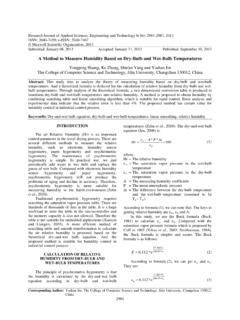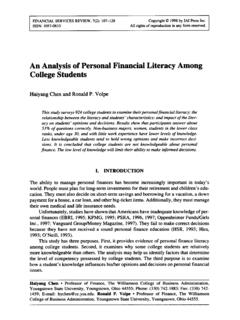Transcription of FINANCIAL PERFORMANCE ANALYSIS-A CASE …
1 Current Research Journal of Social Sciences 3(3): 269-275, 2011 ISSN: 2041-3246 Maxwell Scientific Organization, 2011 Received: March 05, 2011 Accepted: April 06, 2011 Published: May 25, 2011 Corresponding Author: Amalendu Bhunia, Fakir Chand College Under University of Calcutta, Diamond Harbour, South 24-Parganas, Pin-743331, West Bengal, India. Tel: (0)9432953985269 FINANCIAL PERFORMANCE ANALYSIS-A case Study 1 Amalendu Bhunia, 2 Sri Somnath Mukhuti and 2 Sri Gautam Roy1 Fakir Chand College Under University of Calcutta, Diamond Harbour, South 24-Parganas, Pin-743331, West Bengal, India2 Indira Gandhi National Open University, New Delhi, IndiaAbstract: The present study aims to identify the FINANCIAL strengths and weaknesses of the Indian public sectorpharmaceutical enterprises by properly establishing relationships between the items of the balance sheet andprofit and loss account. The study covers two public sector drug and pharmaceutical enterprises listed on study has been undertaken for the period of twelve years from 1997-98 to 2008-09 and the necessary datahave been obtained from CMIE database.
2 The liquidity position was strong in case of both the selectedcompanies thereby reflecting the ability of the companies to pay short-term obligations on due dates and theyrelied more on external funds in terms of long-term borrowings thereby providing a lower degree of protectionto the creditors. FINANCIAL stability of both the selected companies has showed a downward trend andconsequently the FINANCIAL stability of selected pharmaceutical companies has been decreasing at an intense study exclusively depends on the public sectors published FINANCIAL data and it does not compare withprivate sector pharmaceutical enterprises. This is a major limitation of the research. The study is of crucialimportance to measure the firm s liquidity, solvency, profitability, stability and other indicators that thebusiness is conducted in a rational and normal way; ensuring enough returns to the shareholders to maintainat least its market value.
3 The study will help investors to identify the nature of Indian pharmaceutical industryand will also help to take decision regarding investment. Key words: FINANCIAL PERFORMANCE , indian pharmaceutical industry, multiple regressions, performanceindicators, public sector INTRODUCTIONF inance always being disregarded in financialdecision making since it involves investment andfinancing in short-term period. Further, also act as arestrain in FINANCIAL PERFORMANCE , since it does notcontribute to return on equity (Rafuse, 1996). A welldesigned and implemented FINANCIAL management isexpected to contribute positively to the creation of afirm s value (Padachi, 2006). Dilemma in financialmanagement is to achieve desired trade offbetween liquidity, solvency and profitability(Lazaridis et al., 2007). Management of working capitalin terms of liquidity and profitability management isessential for sound FINANCIAL recital as it has a directimpact on profitability of the company (Rajesh andRamana Reddy, 2011).
4 The crucial part in managingworking capital is required maintaining its liquidity inday-to-day operation to ensure its smooth running andmeets its obligation (Eljelly, 2004). Ultimate goal ofprofitability can be achieved by efficient use of is concerned with maximization of shareholders orowners wealth (Panwala, 2009). It can be attained throughfinancial PERFORMANCE analysis . FINANCIAL performancemeans firm's overall FINANCIAL health over a given periodof PERFORMANCE analysis is the process ofdetermining the operating and FINANCIAL characteristics ofa firm from accounting and FINANCIAL statements. The goalof such analysis is to determine the efficiency andperformance of firm s management, as reflected in thefinancial records and reports. The analyst attempts tomeasure the firm s liquidity, profitability and otherindicators that the business is conducted in a rational andnormal way; ensuring enough returns to the shareholdersto maintain at least its market pharmaceutical industry has played a key rolein promoting and sustaining development in the vital fieldof medicines.
5 It boasts of quality producers and manyunits have been approved by regulatory authorities inUSA and International companies associated withthis sector have stimulated, assisted and spearheaded thisdynamic development in the past 58 years and helped toput India on the pharmaceutical map of the world. Thepublic sector has been the backbone of the Indianeconomy, as it has acted as a strategic partner in thenation s economic growth and development. Public sectorenterprises possess strong prospects for growth becausethey harness new business opportunities, and at the sametime expanding the scope of their current Res. J. Soc. Sci., 3(3): 269-275, 2011270 The ability of an organization to analyze its financialposition is essential for improving its competitive positionin the marketplace. Through a careful analysis of itsfinancial PERFORMANCE , the organization can identifyopportunities to improve PERFORMANCE of the department,unit or organizational level.
6 In this context researcher hasundertaken an analysis of FINANCIAL PERFORMANCE ofpharmaceutical companies to understand howmanagement of finance plays a crucial role in the REVIEWF inancial PERFORMANCE analysis is vital for thetriumph of an enterprise. FINANCIAL PERFORMANCE analysisis an appraisal of the feasibility, solidity and fertility of abusiness, sub-business or mission. Altman andEberhart (1994) reported the use of neural network inidentification of distressed business by the Italian centralbank. Using over 1,000 sampled firms with 10 financialratios as independent variables, they found that theclassification of neural networks was very close to thatachieved by discriminant analysis . They concluded thatthe neural network is not a clearly dominant mathematicaltechnique compared to traditional statistical and Kumar (2008) incorporated the time bias factor into the classic business failure prediction Altman (1968) and Ohlson s (1980) models to amatched sample of failed and non-failed firms from1980 s, they found that the predictive accuracy ofAltman s model declined when applied against the 1980 sdata.
7 The findings explained the importance ofincorporating the time factor in the traditional failureprediction (2008) constructed a multivariateprediction model that estimates the probability ofbankruptcy reorganization for closely held firms. Sixvariables were used in developing the hypotheses and fivewere significant in distinguishing closely held firms thatreorganize from those that liquidate. The five factors werefirm size, asset profitability, the number of securedcreditors, the presence of free assets, and the number ofunder-secured secured creditors. The prediction modelcorrectly classified of the sampled firms. Thismodel is used as a decision aid when forming an expertopinion regarding a debtor s likelihood of study has incorporated the FINANCIAL performanceanalysis of the central public sector enterprises in Indiandrug & pharmaceutical Industry.
8 Nor has any previousresearch examined the solvency position, liquidityposition, profitability analysis , operating efficiency andthe prediction of FINANCIAL health and viability of publicsector drug & pharmaceutical enterprises in of the study: The main objectives of thepresent work are to make a study on the overall financialperformance of selected public sector drug &pharmaceutical enterprises in India. More specifically, itseeks to dwell upon mainly (i) to assess the short-termand long-term solvency, (ii) to assess the liquidity andprofitability position and trend, (iii) to know theefficiency of FINANCIAL operations and (iv) to analyze thefactors determining the behavior of liquidity andprofitability. Keeping the above objectives in mind, thefollowing null and alternative hypotheses have beenformulated and tested present study covers two public sector drug &pharmaceutical enterprises listed on BSE.
9 The sample ofthe companies has been selected on a convenient basisand the necessary data have been obtained from CMIE database and public enterprises survey. We selectKarnataka Antibiotics and Pharmaceuticals Ltd. (KAPL)and Rajasthan Drugs and Pharmaceuticals Ltd. (RDPL).The study has been undertaken for the period of twelveyears from 1997-98 to 2008-09. In order to analyzefinancial PERFORMANCE in terms of liquidity, solvency,profitability and FINANCIAL efficiency, various accountingratios have been used. Various statistical measures havebeen used , , , , linear multipleregression analysis and test of hypothesis t-test. RESULTSF inancial analysts often assess the firm's liquidity,solvency, efficiency, profitability, operating efficiencyand FINANCIAL stability in both short-term and analysis provides relative measures of thecompany s PERFORMANCE and can indicate clues to theunderlying FINANCIAL position.
10 For measuring financialposition and FINANCIAL efficiency, appropriate level offinancial PERFORMANCE indicators are required with whomcomparison can be made. Generally liquid ratio, debt-equity ratio, interest coverage ratio, inventory turnoverratio, return on investment ratio and debt to net worthratio are highly useful in determining FINANCIAL position, FINANCIAL PERFORMANCE and the FINANCIAL stability orotherwise of such management. Liquid ratio: It is the ratio of liquid assets to currentliabilities. Liquid ratio is more rigorous test of liquiditythan the current ratio because it eliminates inventories andprepaid expenses as a part of current assets. Usually ahigh liquid ratio an indication that the firm is liquid andhas the ability to meet its current or liquid liabilities intime and on the other hand a low liquidity ratio representsthat the firm's liquidity position is not good.








